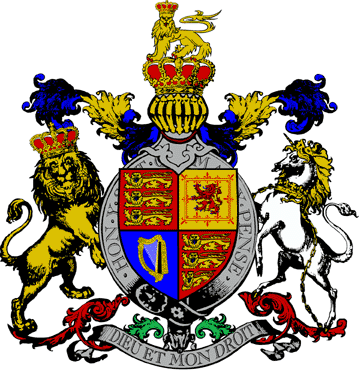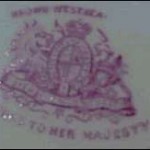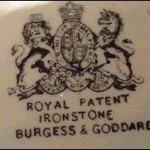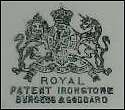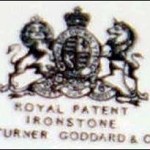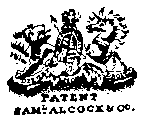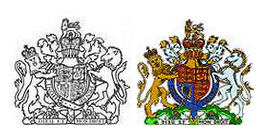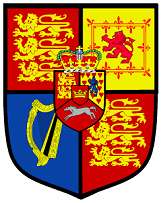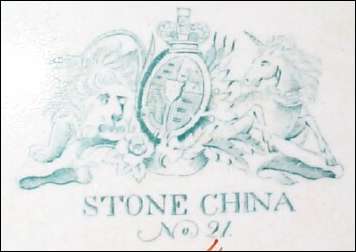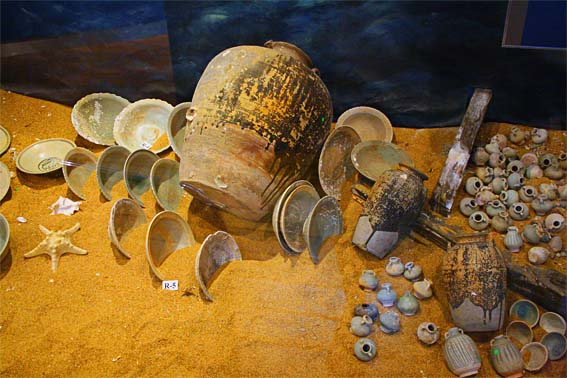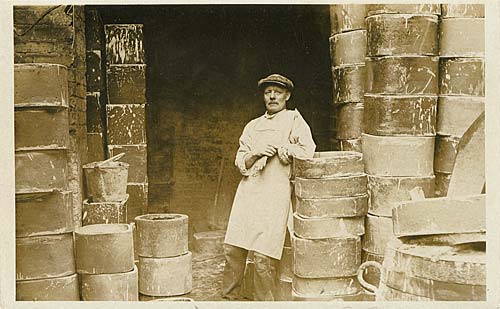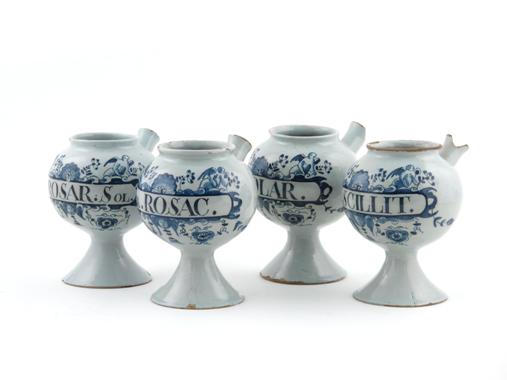Examples of the use of the full British Royal Coat of Arms with the Lion, Unicorn, Shield and usually both mottos.
- Brown Westhead Moore & Co1890+ (to 1904)
- Burgess & Goddard
- Henry Burgesswith name or initials ‘H B’ below. 1864-92
- Henry Alcock & Co 1861-1910
- Hicks & Meigh 1808-1822Use of the pre-1837 British Royal Coat of Arms with the additional centre shield in the main shield.
- Samuel Alcockthis mark appears with or without then name or initials: SAML ALCOCK & Co. S.A. & Coc.1828-53
The Royal Arms may only be used by businesses which are holders of a Royal Warrant. Nowadays Royal Warrants are granted to people or companies who have regularly supplied goods or services for a minimum of five consecutive years to members of the Royal Family.
However in the late 19th and early 20th century many potters who did not have a Warrant (both in England and also foreign firms) also used the Arms (or some similar design) as part of their mark – to gain some sense of importance and value.
In the same way many potters use the name “Royal” as part of their name or trade mark.
From earliest times tradesmen and women have served their sovereign by providing goods and services – from making robes and regalia to repairing roofs and painting walls. The first rewards for this loyal service came in the form of Royal Charters which were granted to the trade guilds, later known as livery companies. The earliest recorded Royal Charter was granted to the Weavers’ Company in 1155 by Henry II. In 1394 Dick Whittington helped obtain a Royal Charter for his own Company, the Mercers, who traded in luxury fabrics.
By the 15th century Royal tradesmen were recognised by means of a Royal Warrant of Appointment – a practice that continues to this day.
In the late 18th century Warrant Holders began displaying the Royal Arms on their premises and stationery.
However, it was Queen Victoria who ensured Royal Warrants gained the prestige they enjoy today. During her 64 year reign the Queen and her family were responsible for granting more Royal Warrants than ever before – more than 2000.
The function of the Royal Coat of Arms is to identify the person who is Head of State. In respect of the United Kingdom, the royal arms are borne only by the Sovereign.
They are used in many ways in connection with the administration and government of the country, for instance on coins, in churches and on public buildings. Queen Elizabeth the First instructed that all churches should have a royal coat of arms to symbolise the fact that the monarch was the head of the Church of England. They are familiar to most people as they appear on the products and goods of Royal Warrant holders.
The belt surrounding the shield bears the motto of the Order of the Garter
(an ancient order of knighthood of which the Queen is Sovereign)
“Hon Y Soit Qui Mal Y Pense”
“Shame to him who evil thinks.”
Below is the motto of the Sovereign
“Dieu et Mon Droit,”
“God and My Right.”
The Royal Coat of Arms of the United Kingdom have evolved over many years since the 1100’s and reflect the history of the Monarchy and of the country, the arms have remained unchanged since Queen Victoria.
The shield shows the various royal emblems of different parts of the United Kingdom: the three lions of England in the first and fourth quarters, the lion of Scotland in the second and the harp of Ireland in the third.
The shield is supported by the English lion and Scottish unicorn.
The plant badges of the United Kingdom – rose, thistle and shamrock – are sometimes displayed beneath the shield.
Change in the Royal Coat of Arms in 1837
The arms have remained unchanged since 1837 when Queen Victoria came to the throne. Therefore it is possible to date pre and post 1837 pottery by these differences.

